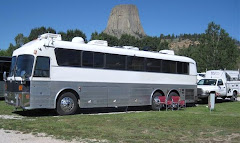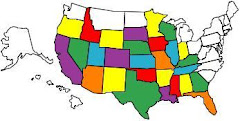Thursday afternoon May 30, 2013 (Sixth travelogue of this trip).
I decided to make this the post a part of original Blytheville travelogue, since our bus thinks it is still on the same trip {grin}. To recap previous posts in our blog, we arrived in Prescott on April 11 and will be leaving tomorrow. That means that the bus has been here 49 days! However, there has been a lot of water under the bridge between when we first got here and today. After we arrived we stayed 2 days and then went back to Denver so that I could teach a class. Shortly after that we went on the trip to Fiji that Pat earned. We returned to Prescott on 5/20. Pat stayed here and I flew to Seattle last week (that trip was documented in a separate travelogue). A special thanks to Jeanne and Bill for being such special hosts and allowing us to park the bus for such a long time.
Speaking of water under the bridge (I chose that phrase knowing that I could transition into this discussion), there is literally a LOT of water under the bridges here in Iowa. Almost every day that we have been here the second time it has rained – sometimes very heavily. Indeed, today all of Iowa is under a flash flood warning. There have been a few tornado watches during our stay – fortunately nothing developed in the area.
Bill was able to get the corn planted in April and got most of the beans in while I was in Seattle. That is a good thing, since the fields are saturated and have standing water (see photo). Worse yet, there is rain in the forecast for a few more days. Last year there was a terrible drought in the mid-west, so the folks back here are not complaining too much.
Water in the fields - lots of rain in IA
Pat and Jeanne put flowers at most of the cemeteries while I was gone. We have been able to visit most of the relatives. The rest of the time, we have relaxed and ate way too much food. While I was gone, Pat and the relatives went to a casino in Osceola, IA.
I arranged to have the drive axle tires on the bus replaced while we were in the area and had some metal parts for the IHC truck project fabricated by a company that has done several projects for me in the past. I really try to do business with companies back here. They have a good attitude and the prices are more than competitive with Denver prices. Indeed, the metal fabrication work I have done at Brown Bear is far less expensive and they usually have the parts done in a day or two.
As noted above, we will head home tomorrow. We make the trip in two days.
That is all for now.
.JPG)
.JPG)
.JPG)
.JPG)
.JPG)
.JPG)
.JPG)
.jpg)
